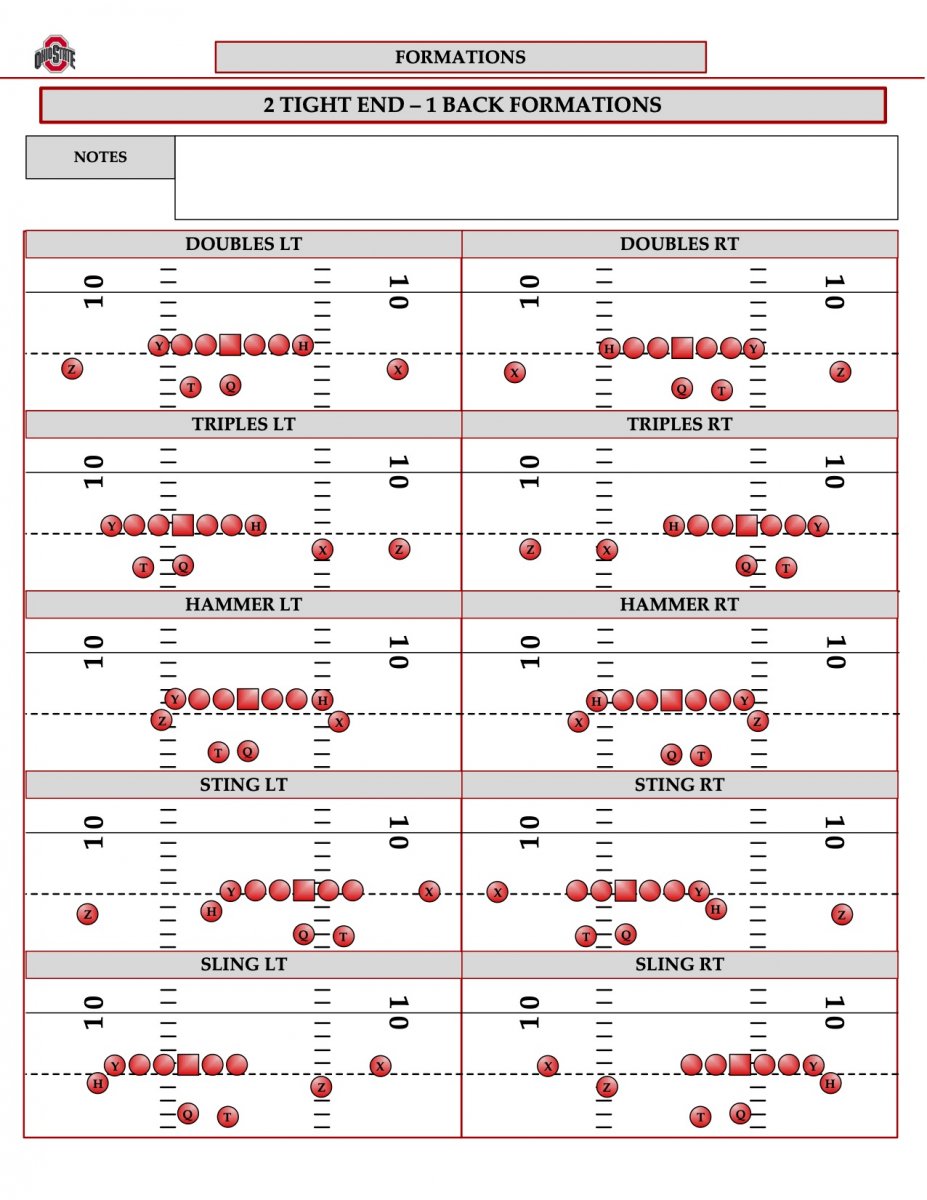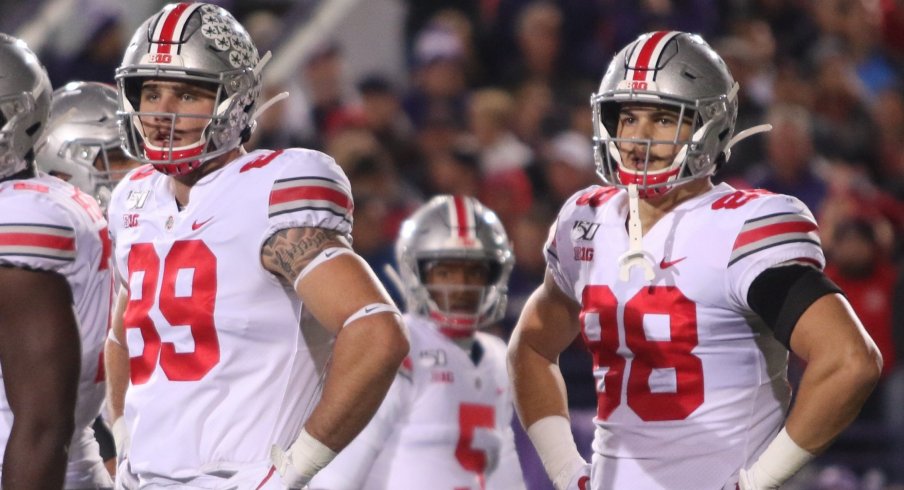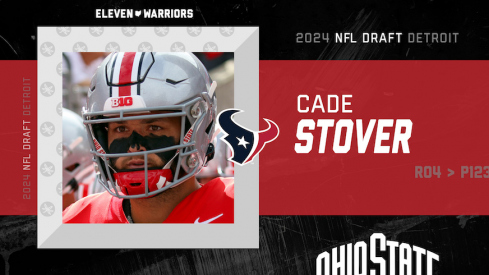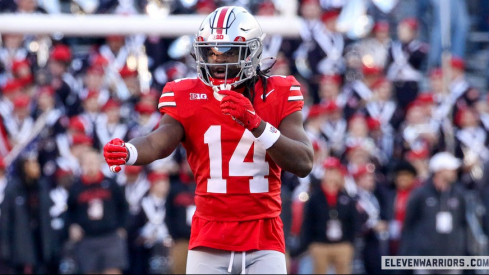On the first snap of Ohio State's 2019 season, Justin Fields lined up in the shotgun, read the defensive end crashing down on a potential handoff, and quickly pulled the ball away from J.K. Dobbins. Instead of running for himself, though, the quarterback set his feet and threw a strike to his receiver sitting in the flat, securing an easy five-yard gain.
The receiver on the play wasn't K.J. Hill, Austin Mack, or Chris Olave, though. It was Jeremy Ruckert, who was inserted in the lineup at Hill's typical 'H' position while Luke Farrell manned the traditional tight end spot.
On the next drive, the pair showed a similar alignment, resulting in a deep touchdown pass to a wide-open Ruckert off a Scissors concept meant to attack the defense's Quarters coverage.
On the Buckeyes' third drive that afternoon, they emerged yet again in the same, two-tight end look into the boundary. This time, the play-call was a downhill, inside zone handoff meant to bounce in their direction (often referred to as Duo at the pro level).
Thanks to solid movement from the tight end pair and some hard running from Dobbins, the play resulted in another solid gain. But the play's true value showed up on the following snap.
The Buckeyes left the same personnel package on the field, this time flipping both tight ends to the right. At the snap, the tight ends blocked down, sucking up the safety as it appeared to be the same Duo call as the previous play, just run to the other side.
But as the safety to their side crept up after reading run, a wide-open Chris Olave darted open behind him for an easy touchdown catch.
You might be asking yourself, 'why are we revisiting a handful of plays from a blowout victory over Florida Atlantic?'
Ever since Urban Meyer set foot on campus as Ohio State's head football coach prior to the 2012 season, the Buckeyes have operated first and foremost as a modern, spread offense, eschewing the traditional fullback position for a third starting receiver. This look, known as 11 personnel (1 running back, 1 tight end) has been accepted as the new standard not only in Columbus but across the rest of the college football world as well.
Throughout the eight seasons since Meyer arrived, there has been little variance from this norm. The Buckeyes occasionally relied on double-tight end sets in short-yardage situations in the fall of 2015 when both Jeff Heuerman and Nick Vannett were there, but the position was also an afterthought at times in Dwayne Haskins' record-setting 2018 campaign, often giving way to a fourth receiver.
Now, with three senior receivers departing for a second straight year, the Buckeyes are incredibly young at that position despite a plethora of talent. Olave and sophomore Garrett Wilson return as expected starters after both broke out in 2019, while incoming freshmen Julian Fleming and Jaxon Smith-Njigba were expected to compete for the third starting spot.
Though both players enrolled early, they only participated in a few practices before COVID-19 shut down spring ball in March. While the Buckeyes wait to find out what their revised, conference-only schedule will look like this fall, one can imagine that training camp may be abbreviated as well, leaving the young receiving duo short on reps before the first game.
If that's the case, Ryan Day and his staff will have a reliable solution in the form of Farrell and Ruckert. Both players saw over 400 snaps last fall and the Buckeye playbook features a variety of ways in which the duo could line up together.

Some may be wondering how the playbook might have to be changed to accommodate this change in personnel, but thanks to Ohio State's concept-based passing game, that shouldn't be a problem. The Buckeyes teach skill players every piece of a route combination, not just the routes most typically run by their positions.
The key for Farrell and Ruckert will be to show they're capable of making plays once the ball has arrived.
"Those tight ends have to show coach Day, ourselves, and the quarterbacks that they're deserving of being number one or number two in the progression," offensive coordinator and tight ends coach Kevin Wilson told reporters in the spring. "More often [than not] you're higher in the progression the way the [play] call is made. We can get into a 2x2 set and they go anywhere from the first read to the last read based on how we flip the formation. It's almost interchangeable. So who do you want to touch the ball?"
But while many fans focus on the number of catches Farrell and Ruckert may tally this fall, the value they provide their team goes far beyond touching the ball.
“What are you doing those other plays?” Wilson added. “They've still got to be great players without the ball.”
Beyond the passing game, though, Ruckert, Farrell, and fellow upperclassmen Jake Hausmann will be key cogs in the rebuilt Buckeye running game. As Master Teague III, Trey Sermon, and others compete for carries, the experienced tight ends may add some interesting wrinkles to the blocking schemes.
As seen against Penn State, the Buckeyes ran a Mid-Zone BASH (Back Away) concept with Fields acting as the primary ball-carrier and Dobbins taking a speed sweep the other way. While the backside DE was left unblocked for Fields to read, Ruckert worked up to the second level and sealed the linebacker, ensuring Dobbins reached the edge untouched.
But these Buckeye tight ends have proven capable of operating outside as well, both as blockers in the screen game...
...and as receivers.
This versatility may be what provides the most value to Justin Fields and the Buckeye offense this fall, as they may be able to show multiple formations without needing to substitute. Imagine the duo lining up in a tight set with both players attached to the rest of the offensive line one play, then quickly splitting out wide the next while the defense is forced to adjust without substituting themselves.
Other potent offenses have seen this formula work at both the college and pro levels. Lincoln Riley's Oklahoma offense tore up the Buckeye defense in 2017 with tight ends Mark Andrews and Dimitri Flowers lining up all over the field to exploit mismatches in both the run and pass games.
Andrews' versatility as both a blocker and receiver allowed the Baltimore Ravens to become a devastating offensive attack at the NFL level. Using two and three-tight end sets, the Ravens set up Lamar Jackson to win the MVP by pounding the ball on the ground while still able to throw downfield thanks to the athleticism of Andrews and others.
Lamar Jackson finds Mark Andrews in the end zone for the second time today! #BALvsCIN @lj_era8 @MAndrews_81
— NFL (@NFL) November 10, 2019
: CBS
: NFL app // Yahoo Sports app
Watch free on mobile: https://t.co/414bcK9I5b pic.twitter.com/Ya8xGvUj7D
According to Ruckert, the Buckeye tight ends spent a good chunk of the offseason looking to emulate that adaptability.
“Their guys are really versatile, and we think that our guys can do kind of the same stuff,” Ruckert said. “With coach Wilson, coach (Tim) Hinton, just watching how they scheme up the run plays, how they play with the speed they play at. We're kind of just studying them right now.”
While seemingly everything about the upcoming college football season remains up in the air, having so much experience at the tight end position may quickly become an extremely valuable asset for Ohio State.
"If we get the ball, as big as we are, if we start playing fast, I think you'll see the ball in their hands," Wildon said "That's just a confidence, knowledge deal. Sometimes it's physical development. But sometimes it's just more knowledge and cutting it loose and rolling.”



